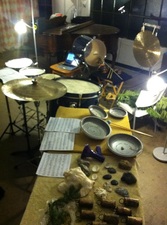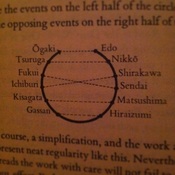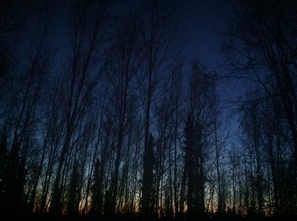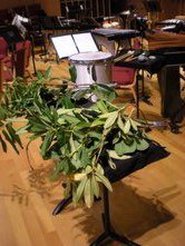

The performance will be at 8pm on July 22nd at The Chapel in Seattle. Tickets are $5-15 sliding scale. A few short excerpts from the debut of The Narrow Aisle to the Deep North can be heard below.
| Nat Evans |
|
 On July 22nd in Seattle, percussionist Bonnie Whiting and cellist Karl Knapp will be in Seattle to present a program of new works by Nat Evans, John Teske, and others at The Chapel. Knapp and Whiting were both professors at the University of Alaska in Fairbanks for the 2012-2013 school year and are doing a series of joint recitals around the country. Each performer will present solo works as well as duets. Karl Knapp will be debuting a short new piece by Nat Evans for solo cello and train sounds on vinyl. Instead of a typical configuration for solo instrument with electronics, the performer is instructed to acquire an LP of train sounds of their choosing and structure a series of cells written out by Evans to best accompany the recording. For the performance, a portable record player will be on stage with the performer - a live dialogue with a phenomenon of recording from the mid-20th century.  Percussionist Bonnie Whiting will be playing Evans' work for solo percussionist, field recordings and natural objects entitled The Narrow Aisle to the Deep North. The title is derived from a travelogue by 17th century Zen hermit poet Basho, entitled The Narrow Road to the Deep North. Basho’s work is written in a style that combines haiku with standard prose, and explores the landscape, natural events, societal phenomenon, observation of physical sensations and people he meets along the way. The sound of the spoken Japanese language and ideas are structured in a circular format that continue to mirror and relate back each other throughout his work (see chart). This solo percussion piece is written within a similar structure and is drawn from the same phenomenon, but in the context of sound. Whereas Basho's haiku capture a moment with two juxtaposed ideas, in this percussion solo there are a series of field recordings from Alaska and Washington juxtaposed with different stations that the percussionist moves amidst, playing traditional western percussion instruments as well as natural objects such as tree branches gathered from wherever the piece is being performed. In this way, The Narrow Aisle to the Deep North becomes a sonic travelogue - a record of Evans' work on his own in Seattle as well as his travels to Alaska to work with Whiting on percussion music in the fall of 2012. The performance will be at 8pm on July 22nd at The Chapel in Seattle. Tickets are $5-15 sliding scale. A few short excerpts from the debut of The Narrow Aisle to the Deep North can be heard below. There are three musical events in January that I'm involved with that are all different from one another in some ways, and totally interconnected in others. The first event - a commission from the Seattle Rock Orchestra is a bit of an outlier from what I usually do (they're an orchestra that does arrangements pop music from the last 60 years), but I'm really excited about the working with a new ensemble and getting to explore some new terrain. The piece, I Am a Rock explores the ubiquity, timelessness and intersection of Simon and Garfunkel, their song I Am a Rock, and geology. We’ve all had experiences like standing in an elevator with granite floors and hearing gentle muzak versions of this song tinkling through the speakers above, hot stone massage while hearing a Chinese lute playing Sounds of Silence on a CD, or been at a house with fake rock speakers, Mrs. Robinson drifting over your conversations in the background...and now I'm combing all that together in a concert work. The orchestra will be playing found rocks, a few string soloists will play abstracted song fragments, and an electronic track of people being interviewed about this music blends these disparate elements together. Details here! It's Saturday, January 12th. Come see 40 people playing rocks. The Narrow Aisle to the Deep North in Los Angeles and San Diego In mid-November I traveled to Fairbanks, Alaska to hear the University of Alaska Fairbanks percussion ensemble - Ensemble 64.8 (yes, that's the latitude there) - play my percussion quintet Unrelated (have a listen to their excellent performance here). While there I worked with visiting professor Bonnie Whiting Smith on a new piece for solo percussionist with electronics. She'll be debuting this new work, The Narrow Aisle to the Deep North, at The Wulf on January 16th, and playing it again at UCSD on January 19th. The Narrow Aisle to the Deep North is designed so that it can be played at different stations that the player moves to between movements, and this is noted throughout the score, though it is not a limiting factor if this is not an option. The title is derived in part from a travelogue by 17th century Zen hermit poet Basho, entitled The Narrow Road to the Deep North. Basho’s work is written in a style that combines haiku with standard prose, and explores the landscape, natural events, and people he meets along the way interacting with both. This solo percussion piece takes a similar path, but in the context of sound. Whereas haiku capture a moment and potentially juxtaposed ideas occurring in our everyday lives in Basho’s work, here there are a series of field recordings that capture the sounds of a trip I took from Seattle Washington to Fairbanks Alaska to hear some of my percussion music played and also work on this piece with percussionist Bonnie Whiting Smith. And, in place of prose, we have a series of stations of instruments creating a narrative sonic landscape that the performer interacts with and illuminates for the audience. The source of the music as alluded to before is drawn from a few days in Alaska discussing and exploring sounds and instruments, observing the changing of light at a northern latitude, stargazing, and watching the aurora borealis; as well as from everyday life for me here in Seattle. Being a sort of record of a period of time, a similar travelogue title seemed appropriate, and since paved roads, and cramped airline aisles are par for the course for anyone working in music, changing road to aisle seemed like a simple and final way to customize this travelogue format for our modern sonic context, as well as describe, if only casually, where this landscape of sound was drawn from. Space Weather Listening Booth at ONN/OF festival I was invited to present something at the ONN/OF festival this year - it's a great festival that features a couple dozen artists who create installations and works based around light in a rented warehouse and runs for just two days. For the festival I am collaborating with Seattle composer John Teske to create a sound installation based on the aurora (aka the northern lights) entitled Space Weather Listening Booth. We're taking geomagnetic data from the earth, information about solar wind and other phenomenon (yes, space weather) and interpreting these things into music and sound. Our allotted installation space is small, so only one or two people at a time will be able to enter and listen. Just as the auroral band moves around the earth slowly, so will our sound shift and move over time, enveloping the listener. In addition to the immersive sound installation, for parts of the festival we'll have private one-minute performances in the booth for one listener at a time - one musician, one audience member. The festival is taking place on January 26th and 27th this year in the old Seattle BMW dealership between Boylston and Harvard on E Pine St.
Next week I'll be boarding an airplane to Fairbanks, Alaska to hear a performance of a percussion ensemble work I wrote a few years ago, Unrelated, at the University of Alaska Fairbanks. While hearing a work be revived again is always nice, I am particularly interested to hear this work again in a new context, as I specify in the score that one of the intentions of this work is to reflect, magnify and draw attention to the specific sounds inherent in different geographic locations. From the score:  The only time Unrelated has been performed live thus far is at Seattle Pacific University in 2009. At that performance the players collected rocks from around campus, and also constructed huge bundles of branches laurel cuttings to shake - laurels a ubiquitous towering hedge we see everywhere in Seattle. Fairbanks is already blanketed in snow, and the professor who has kindly organized this performance, percussionist Bonnie Whiting Smith, made sure that her players had gathered branches and carefully tucked them away by mid-September, and collected stones from the Chena river before it became too cold. So, I am curious to hear how it'll sound in this new context. The third movement of Unrelated has also had a bit of a life on its own outside of this concert work. I took this movement and re-worked it, then added some electronics. This re-worked new piece, Collective Resonance, was featured in the 2011 Music Issue of The Believer, and is available at all the usual digital retailers. Besides working with the percussionists and hearing the performance of Unrelated, I'll also be working with Bonnie to review a bunch of material I've been writing for her that will ultimately end us as a rather long piece for solo percussionist. So far it's looking like this new piece will be incorporating a lot of things we're both interested in: the percussionist speaking, field recordings, natural objects...and snare drum. This is going to be a really fun trip, and hopefully I won't lose a toe due to frostbite: it's supposed to be -10° when I get in on Wednesday.
A few days ago I meandered around downtown Tacoma parking garages with a friend of mine (whom I was visiting), a Conch shell and my trusty digital recorder. Though I've often been fond of reverberant spaces and sounds, I hadn't spent too much time experimenting with playing instruments in these types of places, but I was taken aback by the effect. After I finished with a series of notes the sound would come rush back on top of me, and the first time I had an involuntary physical reaction, not unlike the one where you brace yourself for wind upon hearing it coming in your direction. The sounds echoing around urged further experimentation. Though I've long enjoyed a few recordings by Stuart Dempster that were made up at Ft. Worden in a giant empty cistern that has a 45-second reverb time, I previously didn't understand the full scope of how those pieces must be put together thanks to the reverb, or just how interesting it is to experience that sound coming back on you and making your bones vibrate, but now I get the appeal and have a new appreciation for those sounds...and for numerous other people who've since gone up there to record inspired by the possibilities.
This experimenting has been in preparation for recording the electronics part of a piece I'm doing for winds and fixed media, as well as for the 3rd installment of my iPod/time-site specific pieces, Blue Hour, which will start at sunset and go until it's black. For the winds and fixed media piece I had been using some small pieces of Conch recordings I made in a reverberant stairwell, and I wanted more Conch sound, but then it occurred to me, well, why not have the 5-7 wind players just all play Conch shells during that section? So, I've set about the task of finding a few different sounding conch shells for the different performances of this as of yet untitled work. What could be more exciting than listening to tea kettle sounds followed by 5-7 people playing conch shells? Nothing. Conch shells popped up additionally recently when I was listening to a recording that came out this year of some of Cage's number pieces, which were composed towards the end of his life. This particular recording has one track that has two of his works combined, which is something Cage encouraged during his life, but has taken on greater popularity posthumously as people unpack the great treasure trove of works and ideas left behind. Notably, using this technique percussionist Bonnie Whiting Smith has created 51'15.657" for a speaking percussionist. This combination of works on the aforementioned recording, Two3 and 108, has rich undulating textures, surprising harmonies, and some curious and fanciful sounds coaxed out of Conch shell with water. Also perhaps it's fitting to talk about all this today as it's the birthday of Edgar Varese, and where would any of us composers (Cage included) be without him? |
Nat Evans
Composer, human. Archives
October 2022
Categories
All
|